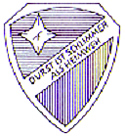
Type: IX-C40
Built by: AG Weser (Bremen)
Launched: 24 August 1942
Commissioned: 10 December 1942
Feldpost Nr.: M50201
Sunk: 28 April 1944
Sunk by: Royal Air Force 612 Squadron
Location sunk: West of Nantes
Position sunk: 45.38º N x 09.43º W (all hands lost, 59 men)
The first Skipper of U-193 was Korvettenkapitän Hans Pauckstadt from 10 December 1942 until March 1944. He had commanded various other U-Boats. He was replaced as Commander by Oberleutnant Dr. Ulrich Abel in March of 1944 and the boat was lost one month later with all hands, including Abel.
“Thirst is worse than homesickness” is the motto on the shield.
U-193 was attached to the 4th U-Bootflotille upon commissioning, then to the 2nd U-Bootflotille at Lorient as a frontboot (combat boat). Under Pauckstadt, U-193 had a patrol in the North and Central Atlantic and on 6 July 1943, two crewmen were wounded in an air attack. The boat had another patrol in the Caribbean, off Florida and in the Gulf of Mexico. While returning from this second patrol, U-193 had to put into El Ferrol (Spain) for repairs and with assistance from Spanish authorities, she remained in that port from 10 February until 20 February 1944.
U-193 was lost on her outbound journey through the Bay of Biscay on Abel’s first war patrol.
One Ship Sunk
U-193 sank one ship during her short life, this while Pauckstadt was commanding, and that was the 10,172 ton American turbine powered tanker TOUCHET on 3 December 1943, a new ship built in 1943. She was owned by WSA and operated by the American Petroleum Corporation. She drew 30 feet, 10 inches with her cargo of 120,000 barrels of heating oil and was making 16.5 knots when attacked. Her master was Jesse Field Bird, and she was armed with one 5 inch, one 3 inch deck gun, and eight 20mm automatic guns. TOUCHET departed Galveston, Texas bound for New York and because she was a fast ship, she sailed independently. Because this was a new ship, she had modern equipment to detect torpedoes in the water and when the master received warning that a torpedo was fast approaching from port, he sounded the general alarm and ordered the ship turned sharply to port.
It was too late, as the torpedo hit portside just behind the bow, blasting a hold some twenty feet long, which immediately flooded the forward hold.
The watch below secured the engines for a short time and the ship turned in the opposite direction. The master ordered full speed ahead but because she was already down by the head, this maneuver only forced the bows underwater.
The master then ordered full speed astern but again the torpedo detection device sounded the alarm that another torpedo was heading in their direction. There was a thud amidships but no detonation – a dud.
It was already hopeless, as the forward portion of the main deck was awash and the ship was sinking, so the master ordered abandon ship. Most of the ten officers, forty men were able to leave the ship in six lifeboats with nineteen of the Armed Guards. The Officer in Charge of the Armed Guards and ten men remained at the after 5 inch gun, hoping to get a shot at the U-Boat.
No luck – at 0330 the third torpedo hit at the engine room and there was a massive explosion. The men went over the side and swam to a nearby raft but as the ship sank, the men feared they would be sucked in (an old sailor’s tale) so they went into the water and tried to swim away from the ship and the raft – nine drowned.
The ship finally slipped beneath the waves by the stern at about 1800 hours. The survivors were redistributed among the six lifeboats. They drifted for more than two days at sea, they were spotted and 43 survivors picked up by the Norwegian steamer SS LILLEMOR. They were landed at Pensacola, Florida. Two hours later, the American destroyer escort USS FALGOUT (DE-324) picked up another eleven survivors. Sixteen more survivors remained afloat until 6 December when USS RAVEN (AM-55) found them and landed them in Galveston, Texas – the very port from which they had departed nearly a week earlier.
The only casualties were the ten Armed Guards who jumped out of their liferaft and tried to swim away from the ship.
EDITOR NOTE – When U-99 sank, OTTO KRETSCHMER (122-+-1985) proved that sinking ships do not create suction, by standing on the bridge of his submarine as it sank out from under him. When he told this story, he said that he did not abandon his ship – it abandoned him. KRETSCHMER had a lot of fun stories.
Back to KTB # 165 Table of Contents
Back to KTB List of Issues
Back to MagWeb Master Magazine List
© Copyright 2003 by Harry Cooper, Sharkhunters International, Inc.
This article appears in MagWeb (Magazine Web) on the Internet World Wide Web. Other articles from military history and related magazines are available at http://www.magweb.com
Join Sharkhunters International, Inc.: PO Box 1539, Hernando, FL 34442, ph: 352-637-2917, fax: 352-637-6289, www.sharkhunters.com
